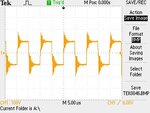mikail7771
Newbie
Hi friends, There is a circuit I designed below in figure 1.
View attachment GATE DRIVE SECTION.bmp
I've put a resistor between the 2.secondary side of a transformer wich has (N = 3 turns ratio) and give a 100Vdc input to the begin of the circuit.
I wanted to explain the test cases by looking at the pictures.
Figure 2. When there is no load between the 2.Secondary
View attachment 5.BMP
Figure 3. Giving a 100V and conneting 100R between 2. Secondary
View attachment 6.BMP
Figure 4. "" 47R ".
View attachment 7.BMP
Figure 5. "" 10R ".
View attachment 8.BMP
The problem is Why the distortion / Spiking's decreases as current increases?
Can we over come this effect when there is no load?
and why is this happening?
Thank you
Best Regards.
View attachment GATE DRIVE SECTION.bmp
I've put a resistor between the 2.secondary side of a transformer wich has (N = 3 turns ratio) and give a 100Vdc input to the begin of the circuit.
I wanted to explain the test cases by looking at the pictures.
Figure 2. When there is no load between the 2.Secondary
View attachment 5.BMP
Figure 3. Giving a 100V and conneting 100R between 2. Secondary
View attachment 6.BMP
Figure 4. "" 47R ".
View attachment 7.BMP
Figure 5. "" 10R ".
View attachment 8.BMP
The problem is Why the distortion / Spiking's decreases as current increases?
Can we over come this effect when there is no load?
and why is this happening?
Thank you
Best Regards.
